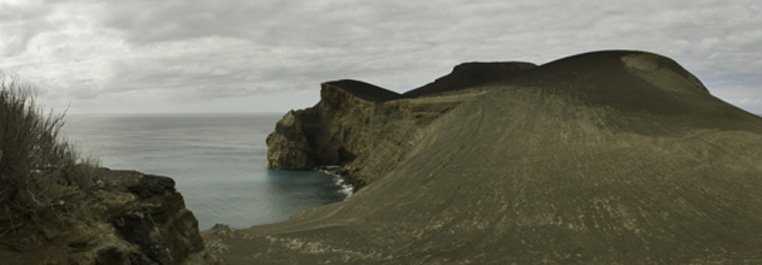Overnight we sailed some 250 nautical miles northwest to the western group of islands that make up the Azorean archipelago. Our destination was Faial, sometimes called the “Blue Island” for its distinctive hedgerows comprised of hydrangeas, the drying heads of which were much in evidence on the lower shoreline of the island but still in bloom as we ascended the island on the afternoon tour. The morning was spent cruising close to the south shore of Faial’s sister island Pico, in the company of playful dolphins; both common dolphins and Risso’s dolphins were in evidence. Fine conditions provided excellent views of the famous volcanic peak along with its secondary craters. By midday were alongside in Horta on Faial.
The afternoon tour of Faial focused on island vulcanism with a visit to Capelinhos where an eruption in 1957-58, which started some distance offshore, added half a kilometer of new land to the island. A small but informative museum provided detailed explanation both of volcanoes in general and of the 20th-century eruption in particular. There were dramatic views of buried buildings with the old and new lighthouses marking the change that has taken place in the position of the coastline.
There is much friendly rivalry among Azoreans as to who lives on the most beautiful island in the archipelago. Those from Faial claim that distinction for themselves but the inhabitants of the neighboring island of Pico counter this by saying that the best thing about Faial is the view of their island, and in particular its eponymous volcanic peak. Today the view of Pico was particularly fine; but the tour of Faial was so charming that the fairest verdict in this dispute would seem to necessitate splitting the award evenly between the two.
Horta itself was a whaling centre into the closing years of the 20th century although whale watching rather than whale hunting is now the activity that supplements the island’s agricultural income. The whale museum in town, housed in the former whaling factory, gave much first-hand information on this extraordinary industry, with documentary footage of courageous but bloody whaling from hand-rowed boats with harpoons along with well-preserved examples of the processing machinery.
Back in town, adjacent to the marina, is Peter’s Café Sport, a Mecca for yachtsmen – as its ceilings, crowded with flags and pennants from around the world, amply testifies – for the anchorage at Horta was and continues to be a welcome first port-of-call for many a transatlantic yachtsman. The café also houses one of the world’s foremost collections of scrimshaw, an activity that accompanied the whaling industry. The artistry of scrimshaw serves as a poignant foil to the whaling industry.









